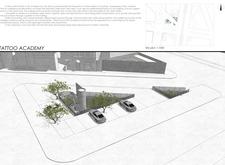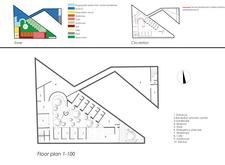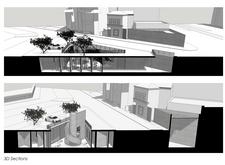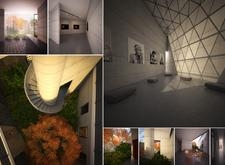5 key facts about this project
The architecture of the Tattoo Academy has been fundamentally designed to support its primary function: providing a comprehensive educational experience for aspiring tattoo artists. The layout is organized around a series of interconnected spaces that facilitate both individual practice and group collaboration. The various workshop areas are equipped with flexible configurations, allowing students to engage in hands-on learning while accommodating a range of activities, from technical training to artistic exploration.
In terms of design, the building strategically incorporates large glass panels, encouraging natural light to permeate the interior. This open approach fosters an inviting atmosphere conducive to creativity and interaction among students and instructors. The use of glass also enables a visual connection between the inside of the academy and the bustling urban environment outside, reinforcing the idea of the academy as a bridge between professional artistry and the greater community.
Prominent within the project is a circular staircase that serves not only as a functional element but also as a symbol of the journey artists undertake in their development. This design feature becomes a focal point in the layout—creating a dynamic circulation path that encourages movement and interaction among users across different levels of the building. By facilitating easy access to all areas of the academy, the staircase enhances the overall user experience and promotes a sense of connectivity among students.
Material choice plays a critical role in the architectural narrative of the Tattoo Academy. Reinforced concrete forms the structural backbone of the building, providing durability while lending an industrial feel to the aesthetic. In contrast, the warmth of wooden finishes and furnishings introduces an element of comfort and invites users to engage deeply with the space. These materials, combined with thoughtfully incorporated greenery around the academy, contribute to a balanced environment that merges the raw with the refined.
The integration of landscaped areas both around and within the academy further reinforces the connection between the students and nature. These green spaces not only enhance the aesthetic quality of the project but also promote well-being and a sense of tranquility. By thoughtfully placing vegetation in proximity to areas of high activity, the design encourages moments of calm and creativity amidst the educational rigor.
The Tattoo Academy also features dedicated exhibition spaces that allow students to display their talents and showcase their work to the community. This aspect of the design highlights the institution's commitment to fostering a thriving artistic community and engaging with the public. By providing a platform for students to present their artistry, the academy strengthens ties with local audiences and promotes dialogue about the significance of tattoo art in contemporary culture.
Overall, the design of the Tattoo Academy in Melbourne represents a sophisticated blend of functionality and aesthetic appeal. By merging educational spaces with community engagement, this project exemplifies a nuanced understanding of the role architecture plays in fostering creativity and professional development. The unique design approaches, such as the prominent use of natural light, the circular staircase as a connective element, and the integration of greenery, distinguish the academy from conventional educational facilities.
For those interested in a deeper appreciation of this architectural project, further exploration of its architectural plans, sections, designs, and overall ideas will provide valuable insights into how this innovative structure redefines the space for artistic education. The rich details and thoughtful design solutions establish the Tattoo Academy as a notable addition to Melbourne's urban landscape, inviting visitors and locals alike to engage with its offerings and immerse themselves in the world of tattoo artistry.


























